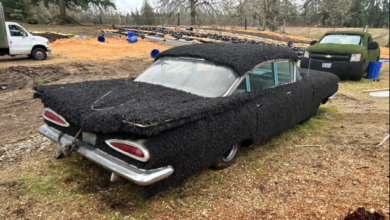1959 Chevy Impala Covered In Black Artificial Grass

Someone on eBay, however, has managed to take me, and probably the rest of the world too, by surprise with a one-of-a-kind Impala they probably believed would look cool. This 1959 Impala wears nothing else than black professional artificial grass for a reason which (I guess) makes a lot of sense: petting it is exciting.
These are the words used by eBay seller dodgegraveyard, who claims in a recent listing that driving this Impala is like owning “a petting zoo.” Tired of detailing cars, the owner of this Impala says the exterior is almost completely done, and parts of the artificial grass were installed using glue, tape, and half-inch screws.

“I did it because it’s exciting to pet it when it’s all cleaned up, and it’s fun, you never have to wash it,” the owner explains. Aside from the black artificial grass that you can see on the body, this 1959 Impala is the original classic that so many people love.
Many people still consider the 1959 Impala the actual first generation, as the original model was launched in 1958 as the top-of-the-line Bel Air. The early success of the car, however, convinced Chevy to upgrade the new nameplate to a stand-alone lineup, something that eventually happened only a year later.

The consensus is that the 1959 Impala is the second-generation series, despite being the first year when the Impala was sold separately from the Bel Air family. In case you are wondering, this Impala is a work in progress in absolutely all regards. The interior, for instance, has already received a series of fixes, including a new windshield and a restored dash, but otherwise, it still requires plenty of work to return to the original glory that a 1959 classic deserves.
Worth knowing, however, is that rust has never been a major concern on this Impala. The seller guarantees that no such metal damage existed before installing the artificial grass on the body. On the other hand, the floors do exhibit some rust, but noth ing that shouldn’t be fixable with the help of professional restoration.

Of course, the rusted floors aren’t necessarily surprising given the age of the car, but at the end of the day, it’s still important to know that the original pans are still there, and someone interested in a full restoration might want to patch them (rather than to go for full aftermarket replacements).The engine that’s supposed to put the wheels in motion of this football field-wannabe is the original 283 (4.7-liter), but we’re not being told if the unit has already been rebuilt or not. There’s a chance it has, especially because the car itself is already a work in progress.

The 1959 Impala could be ordered with the same engines as the 1959 Bel Air, so the base unit was a six-cylinder developing just 135 horsepower. It goes without saying this wasn’t necessarily the best option for those who wanted a thrilling experience behind the wheel of an Impala, but on the other hand, it was a great way to go to the supermarket with an exquisite four-wheel companion.
As a large car, the Impala obviously felt underpowered, so most people decided to go for the base Turbo-Fire. The 283, also installed on this car, developed 185 horsepower thanks to a two-barrel carburetor. Fortunately, Chevrolet knew from the very beginning that its customers would be interested in more power from their shiny new Impalas. And this is the reason the 283 could also be ordered with upgraded power.

The first of them was the unit known as the Super Turbo-Fire, which was fitted with a four-barrel carburetor for a maximum output of 230 horsepower.
The second was the Ramjet configuration which produced 250 horsepower, though few of them ended up being ordered, and even fewer are still around these days.
The top unit was the 348 (5.7-liter), which was available in several configurations, with the top-of-the-range configuration peaking at 335 horsepower.

At the end of the day, this Impala is a one-of-a-kind upgraded model that is, without a doubt, a genuine head-turning machine. Though it could catch everybody’s attention for the wrong reasons, the car is still an Impala, and as I said earlier, it’s the kind of car that deserves to be stored just in the right conditions.
In this case, however, the right conditions should be a little different, especially because, you know, you wouldn’t want the black artificial grass to end up getting damaged in any way, especially given it was installed with glue and screws.